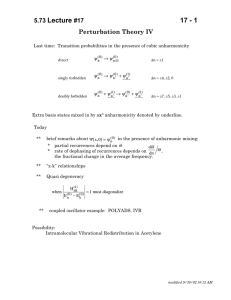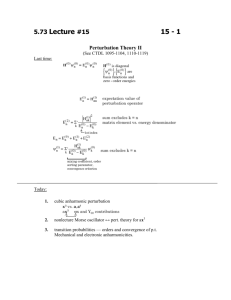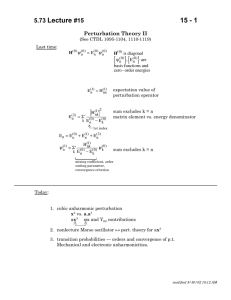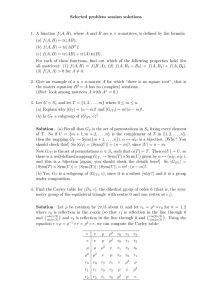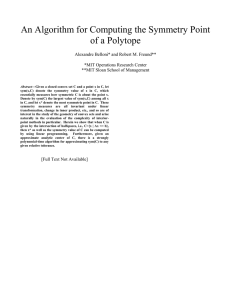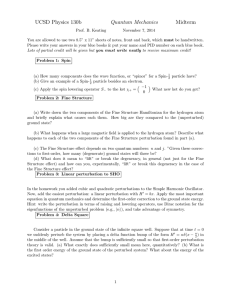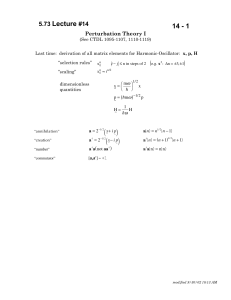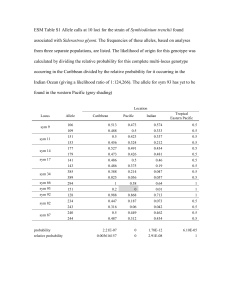16 - 1 Lecture 5.73 #16
advertisement
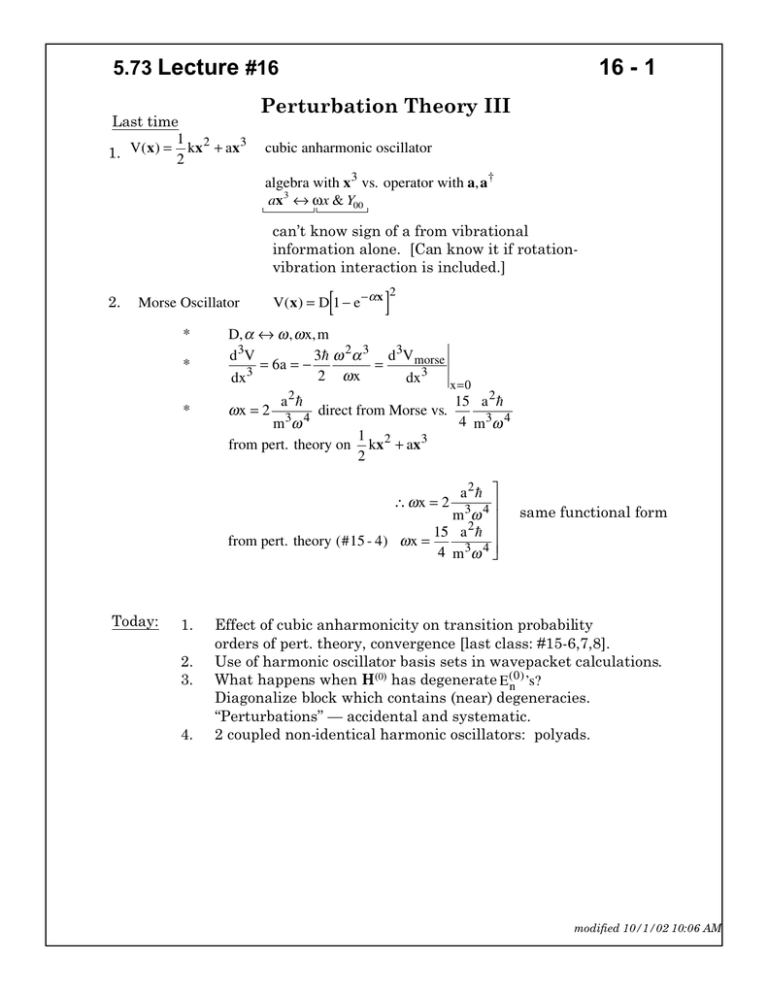
5.73 Lecture #16 Last time 1 2 3 1. V(x) = 2 kx + ax 16 - 1 Perturbation Theory III cubic anharmonic oscillator algebra with x 3 vs. operator with a,a† ax 3 ↔ ωx & Y00 can’t know sign of a from vibrational information alone. [Can know it if rotationvibration interaction is included.] 2. Morse Oscillator * * * [ V(x) = D 1 − e − αx ] 2 D, α ↔ ω , ω x, m 3h ω 2α 3 d 3V morse d 3V = 6a = − = 2 ωx dx3 x=0 dx3 a 2h 15 a 2 h ωx = 2 3 4 direct from Morse vs. 4 m 3ω 4 m ω 1 2 from pert. theory on kx + ax 3 2 a 2h ∴ ωx = 2 3 4 m ω 15 a 2 h from pert. theory (#15 - 4) ω x = 4 m 3ω 4 Today: 1. 2. 3. 4. same functional form Effect of cubic anharmonicity on transition probability orders of pert. theory, convergence [last class: #15-6,7,8]. Use of harmonic oscillator basis sets in wavepacket calculations. What happens when H(0) has degenerate E(0) n ’s? Diagonalize block which contains (near) degeneracies. “Perturbations” — accidental and systematic. 2 coupled non-identical harmonic oscillators: polyads. modified 10/1/02 10:06 AM 5.73 Lecture #16 16 - 2 One reason that the result from second-order perturbation theory applied directly to V(x) = kx2/2 + ax3 and the term-by-term comparison of the power series expansion of the Morse oscillator are not identical is that contributions are neglected from higher derivatives of the Morse potential to the (n + 1/2)2 term in the energy level expression. In particular hω 2 α 4 4 4 (1) E n = V ′′′′(0) x 4! = 7 / 2 x 24 ωx 2 h n x4 n = 4( n + 1 / 2 ) 2 + 2 2mω [ ] contributes in first order of perturbation theory to the (n + 1/2)2 term in En. E (1) n = Example 2 7 7 ω x ( n + 1 / 2 )2 + ω x 12 24 Compute some property other than Energy (repeat of pages 15-6, 7, 8) need ψ n = ψ n(0) + ψ n(1) transition probability: for electric dipole transitions P n ′ ←n ∝ x nn ′ 2 For H - O n → n ± 1 only h 2 x nn+1 = ( n + 1) 2mω for perturbed H-O H(1) = ax3 H(1) ψ n = ψ n(0) + Σ ′ (0) kn (0) ψ k(0) k En − Ek H(1) H(1) H(1) H(1) (0) (0) (0) (0) ψ n = ψ n(0) + nn+3 ψ n+3 + nn+1 ψ n+1 + + nn−1 ψ n−1 + nn−3 ψ n−3 −3hω −hω hω 3hω modified 10/1/02 10:06 AM 5.73 Lecture #16 ψ n(0) + ψ n(1) initial state 16 - 3 effect of x n+4 ψ n(0) anharmonic final state n+7 , n+5, n+4, n+3, n+1 n+3 n+2 n+1 n+1 n n n n–1 n–1 n–2 n–3 n–4 n+5, n+3, n+2, n+1, n–3 n+4, n+2, n+1, n, n–2 n+3, n+1, n, n–1, n–3 n+2, n, n–1, n–2, n–4 n+1, n–1, n–2, n–3, n–5 n-1, n-3, n-4, n-5, n-7 Many paths which interfere constructively and destructively in x nn ′ 2 n ′ = n + 7, n + 5, n + 4, n + 3, n + 2, n + 1, n, n – 1, n − 2, n − 3, n − 4, n − 5, n − 7 only paths for H-O! The transition strengths may be divided into 3 classes 1. direct: n → n ± 1 2. one anharmonic step n → n + 4, n + 2, n, n – 2, n – 4 3. 2 anharmonic steps n → n + 7, n + 5, n + 3, n + 1, n – 1, n – 3, n – 5, n – 7 Work thru the ∆n = –7 path h nxn +7 = 2mω x3n,n+3 1/2 a n + 1)( n + 2)( n + 3) ( n + 4) ( n + 5)( n + 6)( n + 7) 2 (1 2444 3 123 144424443 ( −3hω ) 444 x n,n +3 x n +3,n +4 x n +4,n +7 3/2+3/2+1/2 2 x n+3,n+4 x3n+4,n+7 h3a 4 n 7 x nn+7 ∝ 4 7 7 11 3 2 m ω 2 modified 10/1/02 10:06 AM 5.73 Lecture #16 * 16 - 4 you show that the single-step anharmonic terms go as h 3/2+1/2 a 1/2 x nn+4 ∝ n + 1)( n + 2)( n + 3)( n + 4)] ( [ 2mω ( −3hω ) x nn+4 * 2 h2a 2 n 4 ∝ 2 4 4 6 3 2 m ω Direct term h1 x nn+1 ∝ ( n + 1) 32m1ω 1 2 hn 3a 2 each higher order term gets smaller by a factor 32 23 m 3ω 5 which is a very small dimensionless factor. RAPID CONVERGENCE OF PERTURBATION THEORY! What about Quartic perturbing term bx4? Note that E (1) = n bx 4 n ≠ 0 and is directly sensitive to sign of b! modified 10/1/02 10:06 AM 5.73 Lecture #16 16 - 5 2. What about wave packet calculations? ψ n expressed as superposition of ψ k(0 ) terms Ψ( x,0 ) expanded as superposition of ψ k(0 ) terms (usually only one term, called the “bright state”). But we must also expand ψ k(0 ) as a superposition of eigenbasis, ψ k , terms. Ψ( x ,t ) oscillates at e − iE n t h (1) (2) E n = E (0) n + En + En A state which is initially in a pure ψ n(0) will dephase, then exhibit partial recurrences at ≈ m2π but ωt t= m2π ω * not perfect since E n − E m ≠ hω (n − m) not quite integer multiples! * time of 1st recurrence will depend on E ! because E n+1 − E n−1 decreases as n increases. 2 modified 10/1/02 10:06 AM 5.73 Lecture #16 16 - 6 Degenerate and Near Degenerate E (0) n * * * Ordinary nondegenerate p.t. treats H as if it can be “diagonalized” by simple algebra. (0) CTDL, pages 1104-1107 → find linear combination of degenerate ψ n for which H(1) lifts degeneracy. This problem is usually treated in an abstract way by people who never actually use perturbation theory! Whenever H(1) nk must diagonalize the n,k 2 × 2 ≈1 (0) block of H = H(0) + H(1) E (0) − E n k accidental degeneracy — spectroscopic perturbations systematic degeneracy — 2-D isotropic H-O, “polyads” quasi-degeneracy — safe chunk of H effects of remote states — Van Vleck Pert. Theroy - next time Continuum Philosophy: En 0 particular class of experiments does not look at all En’s - only a given E range and only a given E resolution! Want a model that replaces ∞ dimension H by simpler finite one that does really well for the class of states sampled by particular experiment. NMR IR UV nuclear spins (hyperfine) vibr. and rotation electronic don't care about excited vib. or electronic don't care about Zeeman don't care about Zeeman modified 10/1/02 10:06 AM 5.73 Lecture #16 16 - 7 quasidegenerate block sampled by our specific experiment H= N×N quasidegenerate blocks sampled by other experiments each finite block along the diagonal is an Heffective fit model. We want these fit models to be as accurate and physically realistic as possible. * * fold important out-of-block effects into N × N block → 2 stripes of H diagonalize augmented N × N block - refine parameters that define the block against observed energy levels. next time review V-V transformation 4. Best to illustrate with an example — 2 coupled harmonic oscillators: “Fermi Resonance” [approx. integer ratios between characteristic frequencies of subsystems] p2 1 p2 1 H = 1 + k1 x12 + 2 + k 2 x 22 + k122 x1 x 22 2m 2 2m 2 why not k12x1x2? ψ (n01n) 2 = ψ (n11) ( x1 )ψ (n02 ) ( x2 ) H1(0) E(0) n = hω1( n1 + 1 / 2 ) 1 E(0) n = hω 2 ( n 2 + 1 / 2 ) H(0) 2 E (0) nm = h[ω1( n + 1 / 2 ) + ω 2 ( n + 1 / 2 )] 2 let ω1 = 2ω 2 (m1 = m 2 , k1 = 4k 2 ) systematic degeneracies modified 10/1/02 10:06 AM 5.73 Lecture #16 H (1) = k 122 x 1 x 22 16 - 8 h = k 122 2m 3/ 2 2 ω 1ω 2 1 1/ 2 [(a 1 )( + a †1 a 22 + a †22 + a 2a †2 + a †2a 2 )] aa † + a †a = 2a †a + 1 H(1) nm;kl H(1) = (constants) 6 types of terms n–k m– l a1a 22 –1 –2 [(n + 1)(m + 2)(m + 1)]1/2 a1a†2 2 –1 +2 [(n + 1)(m)(m − 1)]1/2 ( ) H (1) a1 2a†2 a 2 + 1 –1 0 [(n + 1)(2m + 1) ] a1†a 22 +1 –2 [(n )(m + 2)(m + 1)]1/2 a1†a†2 2 +1 +2 [(n )(m)(m − 1)]1/2 ( ) a1† 2a†2 a 2 + 1 2 1/ 2 +1 [ 0 (n)(2m + 1)2 ] 1/ 2 Seems complicated – but all we need to do is look for systematic near degeneracies Recall ω1 = 2ω 2 E(0)/h ω 2 List of Pol y ads by Membership P = 2n1 + n2 [2(n1 + 1/2) + (n2 + 1/2)] (n1 , n2) degeneracy (0,0) 1 1+ 1/2 = 3/2 0 (0,1) 1 1 + 3/2 = 5/2 1 (1,0), (0,2) 2 3 + 1/2 = 7/2 2 (1,2), (0,3) 2 3 + 3/2 = 9/2; (2,0), (1,2), (0,4) 3 11/2 4 3 13/3 5 4 15/2 6 4 17/2 7 etc. 19/2 8 1 + 7/2 = 9/2 3 modified 10/1/02 10:06 AM 5.73 Lecture #16 16 - 9 General P block: 3 + (2 n1 + n2 ) = P + 3 /2 2 # of terms in P block depends on whether P is even or odd EP(0) hω 2 = P+2 states 2 P P even P n1 = , n2 = 0 , n1 = − 1, 2 , … (0 , P) 2 2 P +1 states 2 odd P P −1 , n2 = 1 , … (0 , P) n1 = 2 not 0 because P = 2n1 + n2 is odd H(1) † † † 2 † †2 † 2 = a1a†2 3/2 −3/2 −1/2 −1 2 + a1 a 2 + a1a 2 + a1 a 2 + a1 2a 2 a 2 + 1 + a1 2a 2 a 2 + 1 −3/2 h m ω1 ω 2 k122 2 ∆P= 0 0 –4 +4 –2 +2 ( inside polyad P ,0 2 H (P1) = stuff P − 1, 2 2 M 1, P − 2 0, P ) between polyad blocks 0 0 0 P + 3 / 2 0 P+3/2 0 0 0 0 O 0 0 0 0 P + 3 / 2 H(0) P = hω 2 POLYAD n, m ) ( P ,0 2 P − 1, 2 2 0 P ( 2 • 1) 2 sym 0 0 sym 0 0 0 0 1/ 2 P − 2,4 2 0 P 1/ 2 − 1( 3 • 4 ) 2 0 sym 0 L L0, P 0 0 (even P) 0 0 L 0 1/ 2 0 [(1)(P )(P − 1)] sym 0 Note that all matrix elements may be written in terms of a general formula — computer decides membership in polyad and sets up matrix modified 10/1/02 10:06 AM 5.73 Lecture #16 16 - 10 So now we have listed ALL of the connections of P = 6 to all other blocks! So we use these results to add some correction terms to the P = 6 block according to the formula suggested by Van Vleck. H(2) P nm (1) H H(1) nk km = ∑ (0) (0) P′ En + Em − E(0) k 2 for our case*, the denominator is hω 2 [ P − P ′ ] * For this particular example there are no cases where there are nonzero elements for n ≠ m (many other problems exist where there are nonzero n ≠ m terms) 3 − 4 − 8 =−5 2 30 2 2 4 (2) 22 hω 2 H 6 3 −3 −1 −2 2 −3 = 14 h m ω1 ω 2 k122 2 06 dimensionless 50 75 4 36 − + − = −8 3 4 4 2 105 81 162 12 60 − + − =− 2 4 4 2 2 169 56 197 − − =− 2 4 2 Computers can easily set these things up. Could add additional perturbation terms such as diagonal anharmonicities that cause ω1 : ω2 2 : 1 resonance to detune. modified 10/1/02 10:06 AM 5.73 Lecture #16 16 - 11 For concreteness, look at P = 6 polyad (3,0), (2,2), (1,4), (0,6) H(1) 6 stuff 30 22 30 0 (3 ⋅ 2 ⋅1)1/2 22 sym 0 14 0 sym 06 0 0 14 0 (2 ⋅ 4 ⋅ 3)1/2 0 06 0 0 (1⋅ 5 ⋅ 6)1/2 sym 0 now what are all of the out of block elements of x 1 x 22 that affect the P = 6 block? ∆P = –2 P=6~P=4 ( ) a1 2a†2 a 2 + 1 ( ) ∆P = +2 a1† 2a†2 a 2 + 1 ∆P = –4 a1a 22 H (1)/stuff (0) E(0) P − E P−2 3,0 ~ 2,0 31/2 +2h ω 2 2,2 ~ 1,2 1,4 ~ 0,4 0,6 ~ — 2 1/2 ⋅5 11/2 ⋅ 9 — +2h ω 2 +2h ω 2 — 3,0 ~ 4,0 2,2 ~ 3,2 1,4 ~ 2,4 41/2 31/2 ⋅ 5 21/2 ⋅ 9 –2h ω 2 –2h ω 2 –2h ω 2 0,6 ~ 1,6 3,0 ~ — 2,2 ~ 1,0 1,4 ~ 0,2 0,6 ~ — ∆P = +4 a1†a†2 2 3,0 ~ 4,2 2,2 ~ 3,4 1,4 ~ 2,6 0,6 ~ 1,8 11/2 ⋅ 13 — 21/2 (2 ⋅ 1)1/2 11/2 (4 ⋅ 3)1/2 –2h ω 2 — +4h ω 2 — +4h ω 2 — [4⋅2⋅1]1/2 –4h ω 2 [3⋅4⋅3]1/2 [2⋅6⋅5]1/2 [1⋅8⋅7]1/2 –4h ω 2 –4h ω 2 –4h ω 2 (0) (1) (2) H eff P=6 = H6 + H6 + H6 hω 2 ( 6 + 3 / 2 ) 0 0 0 0 0 0 0 0 0 0 0 0 0 0 0 0 0 0 0 0 0 0 modified 10/1/02 10:06 AM
